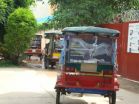(Press-News.org) CAMDEN — One mention of E. coli conjures images of sickness and food poisoning, but the malevolent bacteria may also be the key to the future of renewable energy.
Desmond Lun, an associate professor of computer science at Rutgers University–Camden, is researching how to alter the genetic makeup of E. coli to produce biodiesel fuel derived from fatty acids.
"If we can engineer biological organisms to produce biodiesel fuels, we'll have a new way of storing and using energy," Lun says.
Creating renewable energy by making fuels, like making ethanol out of corn, has been a common practice in trying to achieve sustainability.
However, Lun says, "It's widely acknowledged that making fuel out of food sources is not very sustainable. It's too expensive and it competes with our food sources."
One alternative is to modify the E. coli microorganism to make it overproduce fatty acids, which are used to make biodiesel.
"Fatty acid molecules aren't that different from a lot of fuel molecules," says Lun, a Philadelphia resident. "Biodiesel is something that we can generate quite easily. E. coli has been used as a lab organism for more than 60 years and it's well-studied. We know a lot about its genetics and how to manipulate it. We've got to make quite drastic changes to do it and it requires major intervention."
That's where Lun's computer science expertise comes in. Lun builds computational models of the E. coli organisms to determine what would happen if changes are made. Those changes could include removing enzymes to enhance fatty acid production.
"We call it synthetic biology," he says. "It's sort of the next stage of genetic engineering. Instead of making small changes to specific genes, we're really modifying large sections of genome. We're putting in entirely new traits rather than modifying existing traits."
Lun explains, "The unique aspect of my work is this emphasis on computational modeling as a way of guiding it. Even these simple bacteria are immensely complex. Computational modeling can offer a way to speed up the process and make it a faster, better process."
Fatty acid production in the altered bacteria would be enhanced, paving the way for biofuel development.
INFORMATION:
Lun is collaborating with researchers from Harvard University on his E. coli project.
He teaches computational and integrative biology and biological networks at the Camden Campus of Rutgers, The State University of New Jersey.
Lun received bachelor's degrees in mathematics and computer engineering from the University of Melbourne, Australia. He received his master's in electrical engineering and doctorate in computer science from MIT.
Rutgers-Camden professor engineers E. coli to produce biodiesel
2010-09-04
ELSE PRESS RELEASES FROM THIS DATE:
Americans struggle with long-term weight loss
2010-09-04
Only about one in every six Americans who have ever been overweight or obese loses weight and maintains that loss, according to Penn State College of Medicine researchers.
While that number is larger than most weight-loss clinical trials report, the majority of Americans are still unable to lose weight and keep it off. Identifying those who lose weight and successfully maintain that loss may aid health professionals in developing approaches to help others maintain weight loss, the researchers say.
Two-thirds of the United States adult population is overweight, defined ...
Publication of World Health Report 2000 'an act of remarkable courage,' says school expert
2010-09-04
Ten years on, Martin McKee reflects on report placed health system performance rankings firmly on political agenda.
Martin McKee, Professor of European Health at the London School of Hygiene & Tropical Medicine has contributed one of three commentaries appearing today in the journal Health Policy and Planning, each of which take a different perspective on the World Health Report 2000 on health systems (WHR2000).
It is ten years since the publication of WHR2000, a controversial document which many at the time believed had been published prematurely, and which introduced ...
GOES-13 satellite sees Hurricane Earl's clouds covering the US Northeast
2010-09-04
Hurricane Earl lashed the North Carolina coast last night and this morning, September 3, and is now headed for Cape Cod, Massachusetts. This morning's image from the GOES-13 satellite saw Hurricane Earl's clouds covering most of the northeastern U.S.
The Geostationary Operational Environmental Satellite known as GOES-13 captured an image of Hurricane Earl at 7:32 a.m. EDT this morning, September 3. The image clearly showed a huge Hurricane Earl northeast of North Carolina with cloud cover stretching over the northeastern U.S. A disorganized Fiona was also seen southeast ...
NASA hurricane researchers eye Earl's eye
2010-09-04
Hurricane Earl, currently a Category Two storm on the Saffir-Simpson scale with maximum sustained winds of 100 knots (115 miles per hour), continues to push relentlessly toward the U.S. East Coast, and NASA scientists, instruments and spacecraft are busy studying the storm from the air and space. Three NASA aircraft carrying 15 instruments are busy criss-crossing Earl as part of the agency's Genesis and Rapid Intensification Processes mission, or GRIP, which continues through Sept. 30. GRIP is designed to help improve our understanding of how hurricanes such as Earl form ...
AgriLife research hibiscus breeder comes up with the blue
2010-09-04
VERNON -- Dr. Dariusz Malinowski is seeing blue, and he is very excited.
For four years, Malinowski, an AgriLife Research plant physiologist and forage agronomist in Vernon, has been working with collaborators Steve Brown of the Texas Foundation Seed and Dr. William Pinchak and Shane Martin with AgriLife Research on a winter-hardy hibiscus breeding project.
The project was first a private hobby of the inventors and became a part of the strategic plan of the Texas AgriLife Research and Extension Center at Vernon in 2009. The flower commercialization is a part ...
Queen's study exposes cognitive effects of Parkinson's disease
2010-09-04
Researchers at Queen's University have found that people with Parkinson's disease can perform automated tasks better than people without the disease, but have significant difficulty switching from easy to hard tasks. The findings are a step towards understanding the aspects of the illness that affect the brain's ability to function on a cognitive level.
"We often think of Parkinson's disease as being a disorder of motor function," says Douglas Munoz, director of the Queen's Centre for Neuroscience Studies and a Canada Research Chair in Neuroscience. "But the issue is ...
Increase in Cambodia's vultures gives hope to imperiled scavengers
2010-09-04
While vultures across Asia teeter on the brink of extinction, the vultures of Cambodia are increasing in number, providing a beacon of hope for these threatened scavengers, according to the Wildlife Conservation Society (WCS) and other members of the Cambodia Vulture Conservation Project.
Researchers report that record numbers of vultures have been counted in Cambodia's annual vulture census, with 296 birds of three species found at multiple sites across the Northern and Eastern Plains of Cambodia by the Cambodia Vulture Conservation Project, a partnership of conservationists ...
Afla-Guard also protects corn crops
2010-09-04
Afla-Guard®, a biological control used to thwart the growth of fungi on peanuts, can be used on corn as well, according to a study by U.S. Department of Agriculture (USDA) scientists who helped develop it.
After extensive study and research trials in Texas, Afla-Guard® was registered by the U.S. Environmental Protection Agency (EPA) for use on corn, beginning with the 2009 crop.
Recently retired Agricultural Research Service (ARS) microbiologist Joe Dorner at the National Peanut Research Laboratory in Dawson, Ga., helped develop Afla-Guard®, a biological control for ...
Magnetism's subatomic roots
2010-09-04
The modern world -- with its ubiquitous electronic devices and electrical power -- can trace its lineage directly to the discovery, less than two centuries ago, of the link between electricity and magnetism. But while engineers have harnessed electromagnetic forces on a global scale, physicists still struggle to describe the dance between electrons that creates magnetic fields.
Two theoretical physicists from Rice University are reporting initial success in that area in a new paper in the Proceedings of the National Academy of Sciences. Their new conceptual model, which ...
MIT moves toward greener chemistry
2010-09-04
CAMBRIDGE, Mass. - Phosphorus, a mineral element found in rocks and bone, is a critical ingredient in fertilizers, pesticides, detergents and other industrial and household chemicals. Once phosphorus is mined from rocks, getting it into these products is hazardous and expensive, and chemists have been trying to streamline the process for decades.
MIT chemistry professor Christopher Cummins and one of his graduate students, Daniel Tofan, have developed a new way to attach phosphorus to organic compounds by first splitting the phosphorus with ultraviolet light. Their method, ...



